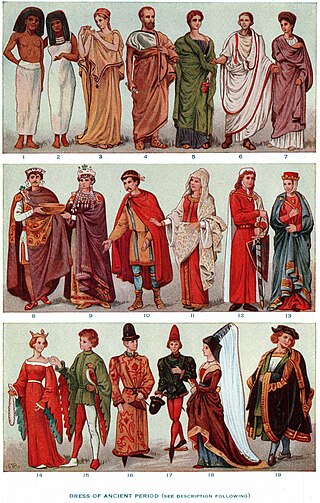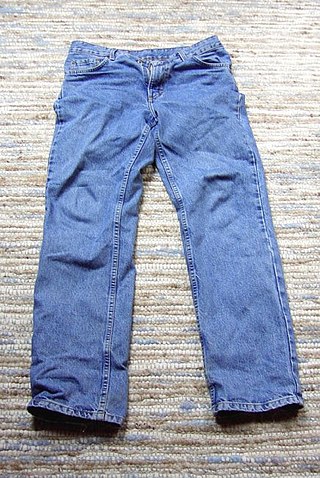
Clothing is any item worn on the body. Typically, clothing is made of fabrics or textiles, but over time it has included garments made from animal skin and other thin sheets of materials and natural products found in the environment, put together. The wearing of clothing is mostly restricted to human beings and is a feature of all human societies. The amount and type of clothing worn depends on gender, body type, social factors, and geographic considerations. Garments cover the body, footwear covers the feet, gloves cover the hands, while hats and headgear cover the head, and underwear covers the private parts.

Jeans are a type of pants or trousers made from denim or dungaree cloth. Often the term "jeans" refers to a particular style of trousers, called "blue jeans", with copper-riveted pockets which were invented by Jacob W. Davis in 1871 and patented by Davis and Levi Strauss on May 20, 1873. Prior to the patent, the term "blue jeans" had been long in use for various garments, constructed from blue-colored denim.

Liuyang is a county-level city, the most populous and the easternmost county-level division of Hunan Province, China; it is under the administration of the prefecture-level city of Changsha, the provincial capital. Located on the northeastern margin of Hunan, the city is bordered to the north by Pingjiang County, to the west by Changsha County and Yuhua District, to the south by Shifeng, Hetang Districts of Zhuzhou and Liling City, to the southeast and the east by Yuanzhou District of Yichun, Shangli, Wanzai and Tonggu Counties of Jiangxi. Liuyang City covers 4,997.35 km2 (1,929.49 sq mi) with registered population of 1,453,246 and resident population of 1,297,700. The city has four subdistricts, 26 towns and two townships under its jurisdiction, its jurisdiction, its administrative centre is at Guankou Subdistrict (关口街道).

Levi Strauss & Co. is an American clothing company known worldwide for its Levi's brand of denim jeans. It was founded in May 1853 when German-Jewish immigrant Levi Strauss moved from Buttenheim, Bavaria, to San Francisco, California, to open a West Coast branch of his brothers' New York dry goods business. Although the corporation is registered in Delaware, the company's corporate headquarters is located in Levi's Plaza in San Francisco.

Overalls or bib-and-brace overalls, also sometimes called dungarees in British English, are a type of garment usually used as protective clothing when working. The garments are commonly referred to as a "pair of overalls" by analogy with "pair of trousers".
Xinchang County is a county in the east-central part of Zhejiang province, administratively under the municipal government of Shaoxing. 430,000 people live in Xinchang.

Metersbonwe Group, marketed as Meters/bonwe is China's leading casualwear apparel company. Metersbonwe opened its first store in Wenzhou on April 22, 1995. By the beginning of 2007, the company operates around 1,800 stores across China and has over 5,000 employees. In 2006 the Group's retail sales exceeded RMB 4 billion, making Metersbonwe the largest casualwear retail brand in the country. The company targets 18- to 25-year-old male and female consumers. Their corporate slogan is "Be Different" (不走寻常路).

China Blue is a 2005 documentary film directed by Micha Peled. It follows the life of Jasmine Li, a young seventeen-year-old worker from Sichuan province, in a Chinese jeans factory, Lifeng Clothes Factory (丽锋服饰制衣有限公司) in Shaxi, Guangdong producing Vigaze Jeans, hence the title. Jasmine earned about half a yuan for one hour's work.

Tangzhuang, sometimes called Tang suit, is a kind of Chinese jacket with Manchu origins and Han influences, characterized with a mandarin collar closing at the front with frog buttons. It is an updated form of the Qing magua, itself a more fashionable adaptation of the riding jacket once worn by Manchu horsemen. Nowadays, the tangzhuang is one of the main formal clothing worn by Chinese men on various occasions; overseas Chinese also wear it as a form of fashion or to express their cultural identity.
Clothing production is an important industry in Mauritius. Clothes are imported and exported in Mauritius. The clothing sector was on the verge of bankruptcy in 2008, but recovered. The sector employed 67,174 people in 2007 and made 1.45 billion dollars in revenue that same year.
Mingxi County is a county of Sanming City, Fujian, People's Republic of China.
The economy of the Northern Mariana Islands benefits substantially from financial assistance from the United States and tourism. The rate of funding has declined as locally generated government revenues have grown. An agreement for the years 1986 to 1992 entitled the islands to $228 million for capital development, government operations, and special programs. Since 1992, funding has been extended one year at a time. The Commonwealth received funding of $11 million for infrastructure, for FY96/97 through FY02/03, with an equal local match.
Shaxi may refer to the following towns in China:

Tiantai County is located in Taizhou, Zhejiang Province, People's Republic of China. Residents mainly speak the Tiantai dialect.

Shaxi is a town of 91,000 in southeastern Jiangsu province, People's Republic of China, located in the middle of Taicang City's jurisdiction. It is about 50 kilometres (31 mi) away from Shanghai Hongqiao International Airport. An ancient town with traditional architecture, Shaxi has a long history and a distinctive culture.

Hanfu are the traditional styles of clothing worn by the Han Chinese. There are several representative styles of hanfu, such as the ruqun, the aoqun, the beizi and the shenyi, and the shanku.
Clothing industry or garment industry summarizes the types of trade and industry along the production and value chain of clothing and garments, starting with the textile industry, embellishment using embroidery, via the fashion industry to apparel retailers up to trade with second-hand clothes and textile recycling. The producing sectors build upon a wealth of clothing technology some of which, like the loom, the cotton gin, and the sewing machine heralded industrialization not only of the previous textile manufacturing practices. Clothing industries are also known as allied industries, fashion industries, garment industries, or soft goods industries.
Zhejiang Semir Garment Co., Ltd, was founded by Qiu Guanghe in the province of Wenzhou, China on December 18, 1996.

Athleisure is a hybrid style of athletic clothing typically worn as everyday wear. Athleisure outfits can include yoga pants, tights, sneakers, leggings and shorts that look like athletic wear, characterized as "fashionable, dressed-up sweats and exercise clothing". Since the 2010s, it has become more common to wear gym clothes outside the gym, whether the wearer is exercising or not.
China Heilan Group is a China-based garment and textile manufacturing company and consumer-orientated holding group. The group focuses on commercial investments in clothing retail, finance, cultural tourism, energy and commercial real estate. It was founded in 1988 and is headquartered in Jiangyin. In 2020, the group was listed as the fourth largest taxpayer in Wuxi.













